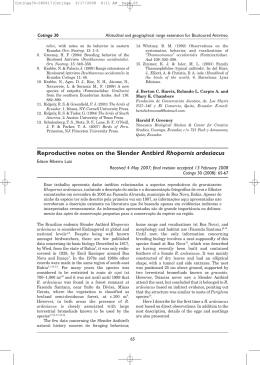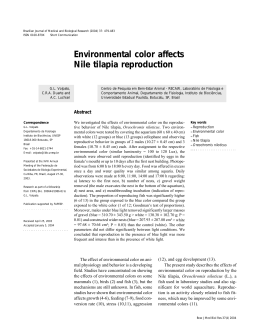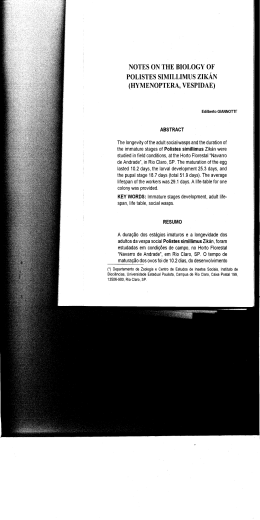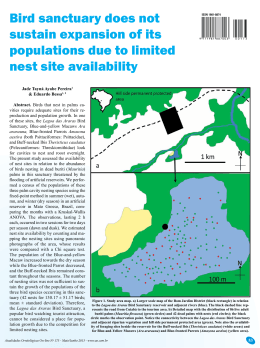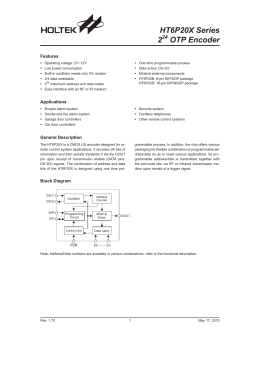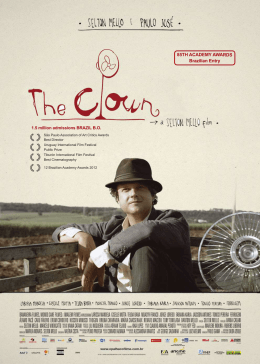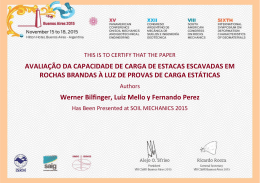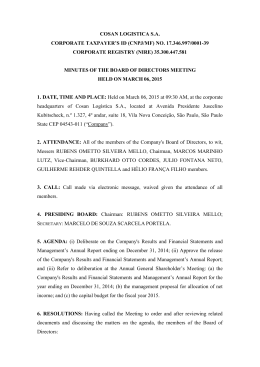Bol. Mus. Biol. Mello Leitão (N. Sér.) 35:35-42. Julho de 2014 35 Reproduction of the Yellow-browed Woodpecker Piculus aurulentus (Picidae) in Atlantic forest, southeastern Brazil Piero Angeli Ruschi1, 2,* José Eduardo Simon1,3 & Fernando Moreira Flores1,4 RESUMO: Reprodução do pica-pau-dourado Piculus aurulentus (Picidae) na Mata Atlântica, sudeste do Brasil. Assim como em muitas espécies de pica-pau (Picidae), o comportamento e a reprodução do pica-pau-dourado (Piculus aurulentus) são desconhecidos da literatura. Aqui, nós descrevemos alguns aspectos da biologia reprodutiva dessa espécie, com base em um ninho descoberto em um remanescente de Mata Atlântica no sudeste do Brasil. O ninho obedecia ao formato conhecido para outras espécies da família, consistindo em uma cavidade vertical escavada em árvore. A postura foi de dois ovos, os quais foram incubados por 21 dias. Macho e fêmea alternaram turnos na escavação do ninho, incubação e cuidado com os filhotes, tendo esses deixado o ninho 26 dias após a eclosão. Incluímos aqui também os detalhes sobre o comportamento de acasalamento. Palavras-chave: nidificação, comportamento reprodutivo ABSTRACT: The breeding behavior of the Yellow-browed Woodpecker (Piculus aurulentus) is unknown like in many other woodpecker species. Here we describe some aspects of its biology based on a nest found in Atlantic Forest habitat of southeastern Brazil. The nest construction matches the pattern typically observed in this family, consisting of a vertical cavity excavated in a trunk tree. Two eggs were laid and incubated for 21 days. Male and female alternated shifts for nest excavation, incubation and taking care of the nestlings, Setor de Ornitologia, Departamento de Zoologia, Museu de Biologia Prof. Mello Leitão/MBML, 29.650-000 Santa Teresa, Espírito Santo, Brazil; 2 Setor de Ornitologia, Departamento de Vertebrados, Museu Nacional/UFRJ, 20940-040 Quinta da Boa Vista, Rio de Janeiro, Brazil. 3 Laboratório de Zoologia dos Vertebrados, FAESA - Faculdades Integradas São Pedro, Campos II, 29030-001 Vitória, Espírito Santo, Brazil. 4 Universidade Estadual de Feira de Santana, Laboratório de Ornitologia, Av. Transnordestina, s/nº, Novo Horizonte, 44036-900, Feira de Santana, BA, Brasil. *Autor para correspondência: [email protected] Recebido: 23 out 2013 – Aceito: 16 mar 2014 1 36 Ruschi et al.: Reproduction of the Yellow-browed Woodpecker which fledge 26 days after hatching, Our findings include details about the mating display, nest excavation, incubation, parental care and offspring development. Key-words: nesting, breeding behavior Introduction Available data on woodpecker behavior and reproduction are sparse or lacking for over half the 198 species of the family (Short, 1982). Much of what is known about the Neotropical genus Piculus is based on studies of the Golden-olive Woodpecker (Piculus rubiginosus) (Skutch, 1956; Short, 1982), whereas information about the reproduction of the Yellow-browed Woodpecker (Piculus aurulentus) is limited to the description of an Argentinean nest found in 1970 (Short, 1970; Winkler and Christie 2002). The Yellow-browed Woodpecker Piculus aurulentus is uncommon, apparently shy in nature, and not often seen. It lives singly or in pairs, foraging in middle tiers where it feeds on ants and their larvae and eggs. This species is endemic to the Atlantic forest, distributed in South and southeastern Brazil, as well as East Paraguay and Northeast Argentina (Winkler & Christie 2002). It is considered near-threatened, and habits the humid montane forest, forest edge, dense second growth and woodland, as well as humid lowland forest (Winkler & Christie 2002). We monitored the reproductive behavior of Piculus aurulentus in an Atlantic forest remnant. We observed the mating display, nest excavation, egg incubation, and parental care until the juveniles left the nest. To the best of our knowledge, this study reports for the first time observations on the reproductive habits and nest description for this species of woodpecker. Material and Methods Field observations took place at the Estação Biológica de Santa Lúcia (for more details see Mendes & Padovan 2000) (19°57’10” to 19°59’00”S and 40°31’30” to 40°32’25”W), located in the municipality of Santa Teresa, State of Espírito Santo, Brazil. Monitoring activities were conducted opportunistically in the morning (05:30 to 12:00) during nest excavation and incubation, and methodically (from 05:30 to 18:00) after hatching, between August 22 and October 15 2007, totaling 120h of monitoring. Nest cavity was inspected with the use of mobile phone camera to determine the dates of egg laying, Bol. Mus. Biol. Mello Leitão (N. Sér.) 35. 2014 37 hatching and nest abandon. We also obtained observations of nesting behavior by digiscope filming with a Nikon Fieldscope ED from a camouflaged shelter located 7 m from the nest. We considered nest attendance as the time that an adult spent either on the nest entrance or into the cavity (does not consider time spent on neighbor trees during other activities (e.g. singing or watching). Fecal sacs removing did not take in consideration the number of fecal sacs carried away by adults, which could not be differentiated all times. Taxonomy and nomenclature follows Winkler & Christie (2002). Results Mating display. A loud ritual in which the male and female dance and stand perched vertically on opposite sides of the same tree trunk was recorded in 22th August. The “dance” was composed of a sequence of random movements in which one bird quickly adjusted its position opposite the other when it moved around the trunk. After a series of these movements, the birds kept the opposing position, from where they performed brief periods of being motionlessness while emitted the song call. Once the male bird emitted the song, the female answered with the same call. These vocal behaviors were repeated several times within 15 seconds until another dance display started again. Copulation was not visualized, though it might have happened inside the nest cavity (see “nest excavation” below). Nest excavation. The nest trunk was chosen after the display, with cavity excavation starting one hour later. The male and female took part in excavation of the nest cavity but they altered in one-hour shifts throughout the day. In each shift the parent that was actively excavating would stop to remove wood chips from the nest entrance every five minutes. Every time a parent threw away wood chips, the bird would spend a brief moment watching out of the nest discarding wood chips. Both parents also practiced vigilance of the nest surroundings, as they communicated to each other via single, double, and triple calls. These calls were emitted from the interior of the nest, the entrance, the trunk, and from the woods. The male and female stayed together inside the cavity for about 5 to 10 minutes while they were changing work shifts. No noise was heard during this time, though we suspect that copulation might have occurred in those moments. Excavation and wood chips removal extended until 26th August, one day before the eggs were laid. Nest description. The nest was excavated 2 m above ground in a 3 m tall 38 Ruschi et al.: Reproduction of the Yellow-browed Woodpecker trunk (14 cm wide at nest height) of a decomposing avocado tree located at the forest edge (secondary growth). The nest consisted of a cavity containing an inclined-tunnel (Simon & Pacheco 2005) with a 15° inclined entrance of dimensions 5 x 4 cm (width and length), which leads to the upper part of the chamber (Fig. 1A). The bottom of the cavity was filled with 4.5 cm of wood chips (Fig. 1B). The nest chamber varied in diameter from 8 cm (bottom) to 10 cm (upper part) along its 34 cm length, while de diameter of the walls varied from 1 to 4 cm. Eggs and Incubation. The clutch was composed of two white eggs with brown spots laid on 27th August. We could not measure the eggs due to the difficulty in accessing them at the bottom of the cavity. Both parents participated in egg incubation activity, which last for 21 days. Female shifts were 20% longer than male. In the morning of September 24th, the female spent 3.5 hours attending to the nest through 2 shifts against 2.8 h by the male (2 shifts also). The male roosted in the nest during both incubation and brooding periods. Parental care. Hatching occurred in 16th September. Both adults shared food with each chick and removed their fecal sacs from the nest cavity (Fig. 2A), disposing of the sacs tens of meters from the nest site. From the 20th day after Figure 1. Nest of the Golden-browed Woopecker. A – Sketch of the nest cavity in a transversal plane view ( I- 4 cm, II- 10 cm, III- 34 cm and IV- 8 cm); B – Photo showing the nest cavity in a transverse plane view; C – Photo of the cavity bottom filled with wood chips; D – Photo showing two nestlings. Bol. Mus. Biol. Mello Leitão (N. Sér.) 35. 2014 39 hatching the male was not recorded removing fecal sacs from the nest, as also did the female three days later (Table 1). During the first 9 days after hatching an adult arrived at the nest entrance and emitted trill calls while waiting for the other adult to leave the nest before entering it. The time that parents spent attending the nestlings during the day reduced through the first 8 days after hatching (from 10 hours to 35 min) until it became severely short (less than a minute each attendance) from the 12th day after hatching (on 27th September) (Table 1). From the age of 17 days the chicks started to be fed at the nest entrance from outside the cavity (Fig. 2B). By this time, the adults advertised their arrival with calls emitted a couple meters from the nest while the young were left alone. Offspring development. The young were naked at hatching (Fig. 1D) and acquired a plumage similar to the female by the time they fledged. Nestlings spent their time climbing the cavity interior by the nest entrance, practicing pecking and probing ectoparasites from the entrance. Such moments of inquietude were followed after long periods of parents’ absence (reaching 4 hours). Pecking might have enlarged the diameter of the chamber’s upper part - in the last days the pecking activities of the young resulted in a small hole at the back of the chamber upper part. From the age of 20 days the young birds slept without the company of the male parent. At this time, the young birds behaved aggressively, as by pecking on the adult breast and tarsi when begging for food (Fig. 2C). At this time, the adults emitted a single call to the young birds after feeding them. Five days later the young birds started to vocalize using the characteristic call of the species (“eeeww”) Figure 2. Still images taken from digiscope video recorded in the present study. A Female carrying away the fecal sac; B - Male feeding nestling through the entrance; C - Nestling pecking on the male’s chest while begging for more food; D - Nestling emitting the single call from the entrance. Ruschi et al.: Reproduction of the Yellow-browed Woodpecker 40 Table 1. Accounting of nestling attendance and fecal sac removal by parents. Week I Parent Week II Week III 18th Sept* 21th Sept* 27th Sept A A A F A F A 24 Sept th 30 Sept Week IV 3 Oct 6 Oct 9 Oct F A F A F A F A F th rd th th 12th Oct Male 3 (3.30’) 2 (1.30’) 4 (1.35’) 2 5 2 5 6 7 6 5 0 3 0 3 0 Female 3 (6.30’) 5 (2.20’) 6 (2) 2 9 2 7 5 6 4 6 6 9 0 2 0 Total 6(10) 7 (4) 10 (3.35’) 4 14 4 12 11 13 10 11 6 12 0 5 0 “A” indicates number of times that adults attended to the nestlings followed by total time spent during day within parenthesis (hour, minutes’), except for those in which the attendance last for less then a minute; “F” indicates how many times a parent removed fecal sacs from the cavity; Dates with “*” could not have data on fecal sac removal gathered because it was too small due to early stage of chicks and carried inside the bill by adults. in response to calls emitted by the adults (Fig. 2D). The brooding period last for 26 days until the last young left the nest. On the day before, it was found in the nest alone, and there were no signs that indicated the other young was predated, thus it might just have left the nest. None of the birds (adults or young) returned to the nest cavity, although we heard the calls from individuals of this species from surrounding areas. Discussion Our data not only represents the first information about reproduction in the Yellow-browed Woodpecker, but some of these observations of reproductive behaviors are also the first reported for the genus Piculus. Overall, however, most of our observations agree with the general pattern found in woodpeckers. The mating display had never been described for any species of Piculus. Sutton (1953) described a display performed by individuals of the Goldengreen Woodpecker, which was later classified as being an agonistic display by Short (1970). The use of forest edges for nesting seems to be common for the Yellow-browed Woodpecker. Short (1970) also presents a record of this species nesting at a forest edge, although it was excavated in a live tree. Different substrata are also used for nesting by other Piculus species. Piculus chrysochloros (Golden-green Woodpecker) has been recorded nesting in trees, arboreal termite and ant nests (Short, 1970), while Piculus rubiginosus (Golden- Bol. Mus. Biol. Mello Leitão (N. Sér.) 35. 2014 41 olive woodpecker Woodpecker) was recorded nesting in a hole of Picoides villosus (Hairy Woodpecker) (Skutch, 1956). Clutch size also varies among Piculus species, as French (1973) reported 2 to 3 eggs for the Golden-green Woodpecker, while Sutton (1953) observed three eggs, and Skutch (1956) found four eggs for this species. Our findings about the Yellow-browed Woodpecker agree with those presented by Skutch (1956) on the Golden-olive Woodpecker, pointing that these species share some similarities regarding parental care and the development of their young: longer incubation periods during day by female than by male; male roosts with young in the nest; feeding is done by both parents through regurgitation at a rate of about once an hour; juveniles leave nest during the fourth week after hatching. In contrast, the adult male of the Golden-olive Woodpecker is reported to continue roosting in the nest after young fledge (Skutch, 1956), while in our study the nest cavity was not used by any individual after the young fledge. The absence of one of the two young birds during our survey could be explained either by early cavity abandonment or by predation. Skutch (1956) reported the disappearance of two juveniles of the Golden-green Woodpecker plus a third one found dead. These records suggest the possibility that predation might be a frequent occurrence on Piculus nests. Acknowledgements We thank the Museu de Biologia Mello Leitão for permission to search in Estação Biológica de Santa Lúcia. We also thank William Bryan Jennings for reviewing the English language and giving interesting insights on the manuscript. Literatura Cited French, R. 1973. A guide to the Birds of Trinidad and Tobago. Wynne Wood, Livingston Publ. Co. pp xix + 470. Short, L. L. 1970. Notes on the habits of some Argentine and Peruvian woodpeckers (Aves, Picidae). American Museum Novitates, 2413: 37pp. Short, L. L. 1982. Woodpeckers of the World. Delaware Museum Natural History, Greenville, Delaware, 676 p. Simon, J. E. & Pacheco, S. 2005. On the standardization of nest descriptions of neotropical birds. Ararajuba 13 (2):7-18. 42 Ruschi et al.: Reproduction of the Yellow-browed Woodpecker Skutch, A. F. 1956. Roosting and nesting of the Golden-olive woodpecker. Wilson Bulletin, 68: 118-128. Sutton, G. M. 1953. Bronzed Woodpecker. Wilson Bulletin, 65: 65-67. Winkler, H. & Christie, D.A. 2002. Family Picidae (Woodpeckers). In J. del Hoyo; A. Elliot & J. Sargatal, eds. Handbook of the birds of the world. Barcelona, Lynx Editions 7: 296-555.
Download
